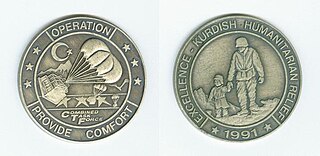
Operation Provide Comfort and Provide Comfort II were military operations initiated by the United States and other Coalition nations of the Persian Gulf War, starting in April 1991, to defend Kurdish refugees fleeing their homes in northern Iraq in the aftermath of the Gulf War, and to deliver humanitarian aid to them. The no-fly zone instituted to help bring this about would become one of the main factors allowing the development of the autonomous Kurdistan Region.
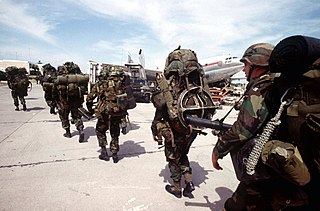
Operation Uphold Democracy was a multinational military intervention designed to remove the military regime led and installed by Raoul Cédras after the 1991 Haitian coup d'état overthrew the elected President Jean-Bertrand Aristide. The operation was effectively authorized by the 31 July 1994 United Nations Security Council Resolution 940.

Michael R. Lehnert is a retired major general of the United States Marine Corps. He supervised the construction and served as the first commandant of the Guantanamo Bay Detention Camp.
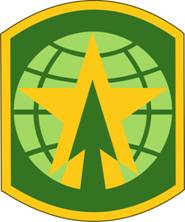
The 16th Military Police Brigade is a military police brigade of the United States Army headquartered at Fort Liberty, North Carolina. This brigade has the only airborne-qualified military police units in the U.S. Army, outside of the 82nd MP Company of the 82nd Airborne Division. It provides law enforcement and police duties to Fort Liberty, and for the XVIII Airborne Corps when deployed. As a brigade with organic airborne units, it is authorized a beret flash and parachute wing trimming, and the shoulder sleeve insignia was authorized to be worn with an airborne tab. According to U.S. Army's Institute of Heraldry, the shoulder sleeve insignia "was amended to delete the airborne tab effective 16 October 2008" when jump status of the brigade was terminated; however, various elements of the brigade remain on jump status.
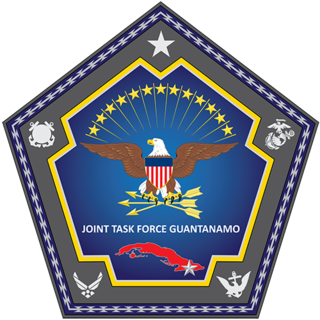
Joint Task Force Guantanamo (JTF-GTMO) is a U.S. military joint task force based at Guantanamo Bay Naval Base, Guantánamo Bay, Cuba on the southeastern end of the base. JTF-GTMO falls under US Southern Command. Since January 2002 the command has operated the Guantanamo Bay detention camps Camp X-Ray and its successors Camp Delta, Camp V, and Camp Echo, where detained prisoners are held who have been captured in the war in Afghanistan and elsewhere since the September 11, 2001 attacks. From the command's founding in 2002 to early 2022, the detainee population has been reduced from 779 to 37. As of October 21, 2022, the unit is under the command of U.S. Army Brigadier General Scott W. Hiipakka.
Camp Bulkeley is an encampment within the United States Naval Station Guantanamo Bay. Camp Bulkeley was constructed between 1943–45. Originally, the camp was constructed to house Marines that were permanently stationed at the United States Naval Station, Guantanamo Bay. Later, the camp was named for Vice Admiral John D. Bulkeley, who was in charge of the base during 1964, when Cuba had accused the United States of stealing water.

The 505th Parachute Infantry Regiment, originally the 505th Infantry Regiment, is an airborne infantry regiment of the United States Army, one of four infantry regiments of the 82nd Airborne Division of the United States Army, with a long and distinguished history.
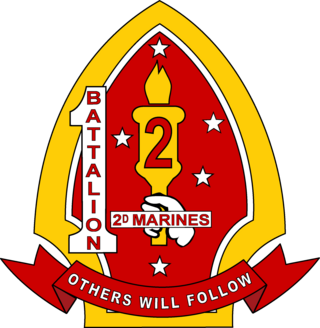
1st Battalion, 2nd Marines (1/2) is an infantry battalion in the United States Marine Corps based out of Marine Corps Base Camp Lejeune, North Carolina, consisting of approximately 900 Marines and sailors. The battalion, callsign "Typhoon'" falls under the command of the 2nd Marine Regiment and the 2nd Marine Division.
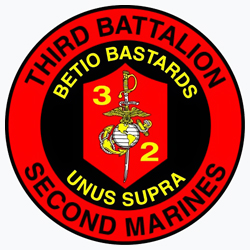
3rd Battalion, 2nd Marines (3/2) is an infantry battalion in the United States Marine Corps based in Marine Corps Base Camp Lejeune, North Carolina. Comprising approximately 1000 marines and sailors and nicknamed the "Betio Bastards", they fall under the command of the 2nd Marine Regiment of the 2nd Marine Division.

2nd Battalion, 2nd Marines (2/2) is a light infantry battalion in the United States Marine Corps based out of Marine Corps Base Camp Lejeune, North Carolina. Also known as "The Warlords", it consists of approximately 1,300 marines and sailors and normally falls under the command of the 2nd Marine Regiment and the 2nd Marine Division.

3rd Battalion, 6th Marines (3/6) is an infantry battalion in the United States Marine Corps based out of Camp Lejeune, North Carolina. Also known as "Teufelhunden", it consists of approximately 1000 Marines and Sailors. They fall under the 6th Marine Regiment and the 2nd Marine Division.
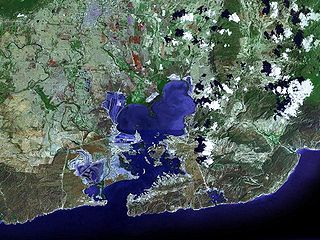
Guantánamo Bay is a bay in Guantánamo Province at the southeastern end of Cuba. It is the largest harbor on the south side of the island and it is surrounded by steep hills which create an enclave that is cut off from its immediate hinterland.
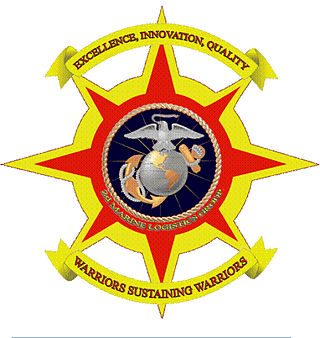
The 2nd Marine Logistics Group is a logistics unit of the United States Marine Corps and is headquartered at Marine Corps Base Camp Lejeune, North Carolina. 2nd MLG was formerly known as 2nd Force Service Support Group (FSSG), reorganized with its sister FSSGs into Marine Logistics Groups in 2005. The 2nd MLG is composed of approximately 8,000 marines and sailors.

2nd Battalion, 6th Marines (2/6) is an infantry battalion in the United States Marine Corps based out of Camp Lejeune, North Carolina. Also known as "The Ready Battalion" or "2/6 Spartans", it consists of approximately 800 Marines and Sailors and falls under the command of the 6th Marine Regiment and the 2nd Marine Division.
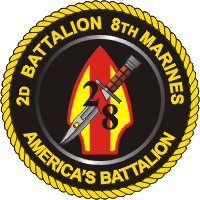
2nd Battalion, 8th Marines (2/8) is an infantry battalion in the United States Marine Corps based in Marine Corps Base Camp Lejeune, North Carolina consisting of approximately 900 Marines and Sailors. Nicknamed "America's Battalion," they fall under the 8th Marine Regiment and the 2nd Marine Division.

The 1st Battalion, 6th Marines (1/6) is an infantry battalion in the United States Marine Corps based in Camp Lejeune, North Carolina. It consists of approximately 1,100 marines and sailors. They fall under the command of the 6th Marine Regiment, the 2nd Marine Division of the II Marine Expeditionary Force.
Operations Safe Haven and Safe Passage were operations by the United States Joint Task Force designed to relieve the overcrowded migrant camps at Guantanamo Bay Naval Base. Safe Haven established four camps on Empire Range, Panama, to provide a safe haven for up to ten thousand Cuban migrants. Safe Passage then returned the migrants to Guantanamo after the crowded conditions could be alleviated. These migrants had attempted to enter the United States illegally by crossing the Florida Straits in summer 1994. The operation was conducted under the command of General Barry McCaffrey and the direction of Clinton administration.

The Marine Corps Security Force Regiment is a dedicated security and anti-terrorism unit of the United States Marine Corps. It provides security forces to guard high-value naval installations, most notably those containing nuclear vessels and weapons. It also provides Fleet Anti-terrorism Security Teams (FAST) and Recapture Tactics Teams (RTT). Marines who complete Security Forces training are assigned a secondary Military Occupational Specialty (MOS) of 8152, while instructors can earn 8153.

The 43rd Military Police Brigade is a military police brigade of the United States Army. It is part of the Rhode Island National Guard.

The Haitian refugee crisis, which began in 1991, saw the US Coast Guard collect Haitian refugees and take them to a refugee camp at Guantanamo Bay. They were fleeing by boat after Jean-Bertrand Aristide, the democratically elected president of Haiti, was overthrown and the military government was persecuting his followers. The first camp reached a maximum of 12,500 people. It was then reduced to 270 refugees who either had HIV or were related to someone who did. The reduction was the result of the US policy adopting a strict policy of repatriation for both those found at sea and most of those living in Guantanamo. The HIV+ refugees were quarantined in a section of the military base known as Camp Bulkeley and faced human rights violations. They were brought to the United States after US District Judge Sterling Johnson Jr. ruled the camp was an "HIV prison camp."






















